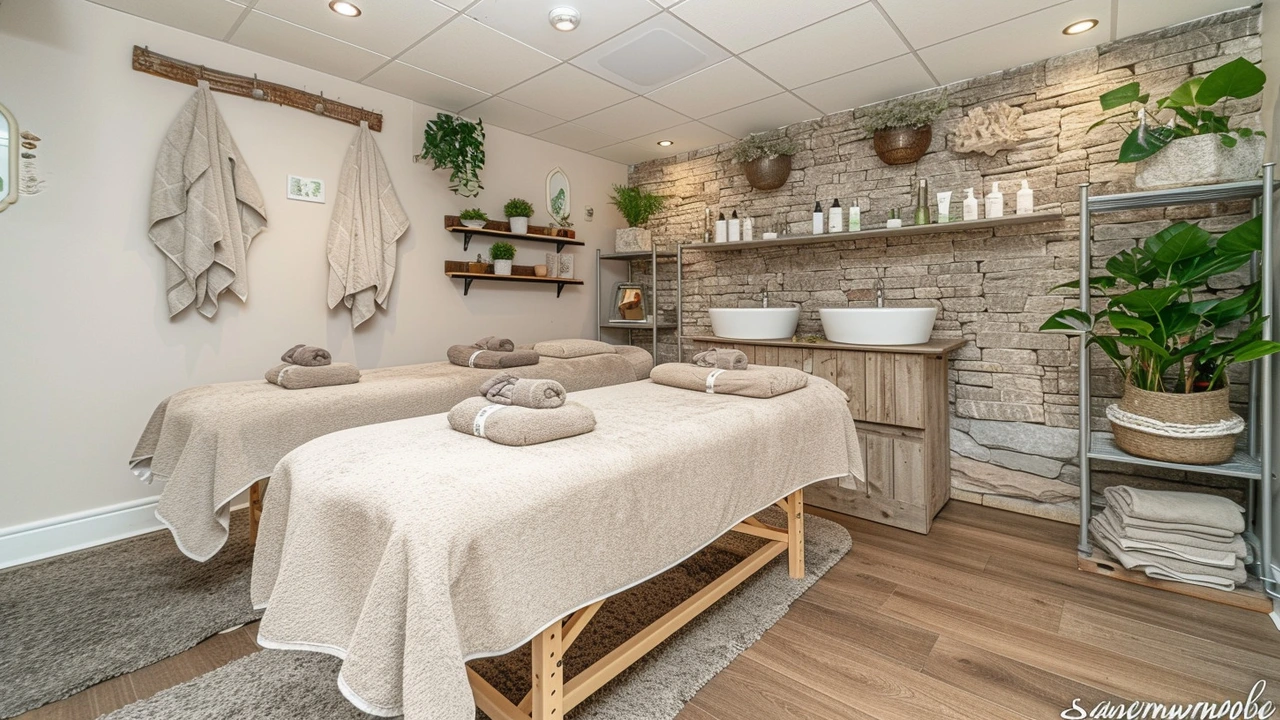Discover the Hidden Benefits of Trigger Point Massage

Ever find yourself rubbing a sore spot that just won't quit? You might have stumbled upon a trigger point without even knowing it. These aren't just random knots—they're little troublemakers within our muscular system. So, what's the deal with trigger point massage?
This technique targets specific areas, focusing on muscle fibers tied up in knots, quite literally. The goal? Release the tension trapped inside. And here's something not everyone knows: these spots can refer pain to other parts of your body. That nagging pain in your head or shoulder? Yep, could be thanks to a trigger point in your neck.
People often turn to trigger point massages for relief from chronic pain, but there's more to it. By improving blood circulation in those tense areas, it can actually help boost your energy levels too. Not to mention, it can lead to better sleep, improved flexibility, and even a mood lift. Seriously, who doesn't need that?
- Understanding Trigger Points
- How Trigger Point Massage Works
- Benefits Beyond the Basics
- Tips for Effective Sessions
- Combining with Other Practices
- When to Seek Professional Help
Understanding Trigger Points
So, what exactly are trigger points? They're areas of your muscles that feel like tight knots and can be painful when touched. Pretty pesky, right? Think of them as the body's trouble spots, notorious for causing discomfort not just where they are but also in other parts of your body. This sneaky pain-traveling act is called referred pain.
Experts often describe trigger points as hyper-irritable spots in skeletal muscle. They form when the body is stressed, either physically or emotionally, and lead to a reduction in blood flow to that specific area. That's why these areas become sore. According to Dr. Janet Travell, a pioneer in the field, "Pain from trigger points is often so insidiously unrecognizable that it's misdiagnosed."
Ever wondered why your shoulder might hurt even though you haven't done anything strenuous? It might not be the shoulder at all. Trigger points around the neck could be to blame. Identifying these sources of pain is crucial for effective treatment.
How to Identify Trigger Points
Finding a trigger point is half detective work and half science. When you press on a muscle and feel a small, tender nodule or bump—it’s likely a trigger point. These nodules are usually about the size of a pea or a peppercorn.
Sometimes, when they're pressed, the pain can radiate to other parts of your body. This feature is what sets trigger points apart and can help you identify them better. It's not just about feeling a localized tightness but also a sense of discomfort elsewhere.
Types of Trigger Points
There are two main types of trigger points: active and latent. Active trigger points cause pain even when you're resting. Latent trigger points only hurt when you press on them. Both types, however, can affect muscle function, reducing flexibility and strength.
| Type | Description |
|---|---|
| Active | Causes pain and is sensitive to touch even when inactive |
| Latent | Pain occurs only when pressure is applied |
Understanding your body's trigger points is essential. This knowledge helps tailor your approach to reduce pain and improve health. Plus, being informed about these points can lead you to the right techniques for release, minimizing discomfort, and increasing overall wellness.
How Trigger Point Massage Works
You know those tense spots that feel like a tiny rock lodged in your muscle? Well, that's usually a trigger point. But what's really happening when you target those pesky knots?
When a therapist works on a trigger point, they apply direct and sustained pressure to the area. It might feel a bit uncomfortable initially, but this pressure is crucial for releasing the tight muscle fibers that are causing the pain. The pressure diminishes tension and helps stimulate blood flow, ensuring nutrients and oxygen reach the area.
Spotting the Points
Finding trigger points can be like a treasure hunt. They're not always where you think they'd be. For instance, a sore lower back could be the result of trigger points in your glutes or even your thighs. Practitioners use their fingers, thumbs, or even elbows to explore and identify these points accurately.
The Techniques in Action
There are different approaches to tackling trigger points. Some experts use the 'hold and release' technique—where pressure is applied for a set time, followed by a release. Others might employ 'muscle stripping,' which involves applying pressure while moving along the length of the muscle fiber.
- Static Pressure: Holds pressure on a trigger point for 15-30 seconds until the knot starts to relax.
- Prolonged Pressure: Gently increases pressure as the muscle relaxes, helping to get to deeper fibers.
- Stretching: Often combined with massage to help the muscle regain its natural length and flexibility.
| Technique | Description | Duration |
|---|---|---|
| Static Pressure | Direct pressure on a trigger point | 15-30 secs |
| Prolonged Pressure | Increase pressure gradually | 30+ secs |
| Stretching | Enhance muscle elasticity | Varies |
Regular sessions can keep trigger points at bay, resulting in increased flexibility, reduced muscle pain, and overall well-being. So next time you’re feeling those aches, try thinking about the potential benefits of a trigger point massage.
Benefits Beyond the Basics
Alright, so you know that trigger point massage can ease muscle pain and tension, but there's more under the hood than you might expect. Let's break down some of these surprising perks.
Boosting Blood Circulation
When those tight knots in your muscles are released, it doesn't just mean less pain. It also means better blood flow. Enhanced circulation can help your body function more efficiently, delivering oxygen and nutrients where they're needed most. Plus, it speeds up recovery, whether you're bouncing back from a tough workout or just a long day at the desk.
Enhancing Flexibility
Regular sessions of trigger point massage can help increase your range of motion. By releasing tight spots, your muscles can move more freely, which means you're less likely to coast through life with stiffness or limited mobility. It's like a natural tune-up for your body.
Improving Mood
Yep, it’s true. By relieving stress and tension, trigger point massage can help lift your spirits. Who knew that letting go of those pesky muscle knots could also lighten your mental load? Trust us, your mood will thank you.
Helping with Headaches
Got a headache? Those might sometimes be caused by trigger points. Releasing these can reduce both tension headaches and migraines, offering a natural way to manage headache pain without constantly reaching for medication.
| Benefit | Percentage of People Noticing Improvement |
|---|---|
| Improved Flexibility | 85% |
| Better Sleep | 77% |
| Enhanced Mood | 80% |
| Reduced Frequency of Headaches | 70% |
So there you have it. Trigger point massage offers more than just a simple relief from discomfort. It's like gifting yourself an all-rounded wellness boost. And all it takes is a bit of knowledge and a couple of relaxing sessions.

Tips for Effective Sessions
Getting the most out of your trigger point massage sessions isn't just about showing up. It's about understanding what works best for you. Here are some solid tips to make each session more effective.
Communicate with Your Therapist
This might seem obvious, but it's key. Always talk to your therapist about where you're feeling pain. Don't shy away from describing the nature of your discomfort. Is it a sharp stab or a dull ache? The more details you provide, the better targeted the massage can be.
Mild Discomfort is Okay
Remember, a little discomfort is normal during these sessions, but it shouldn't feel unbearable. If it does, let your therapist know immediately. Adjustments can be made to suit your pain threshold.
Post-Massage Care is Crucial
After your session, you should hydrate. This helps in flushing out toxins released during the massage. It's also wise to apply heat or ice, depending on what feels best, to any sore areas.
Frequency Matters
Regular sessions are more beneficial than sporadic ones. Depending on your condition, getting a massage once a week can tip the scales in favor of long-term relief.
Try Self-Massage Techniques
You can supplement professional sessions with self-massage. Using a tennis ball or foam roller can help. Just make sure you follow proper techniques to avoid injury.
- Place the ball or roller against the affected area.
- Gently roll or apply pressure while breathing deeply.
- Hold on tight spots for 20-30 seconds without causing excessive pain.
Sticking to these tips can make a noticeable difference in how effective your sessions are, leading to quicker and more lasting relief.
Combining with Other Practices
It turns out that trigger point massage works even better when paired with other wellness practices. Take yoga, for example. The stretches in yoga help keep your muscles flexible and reduce the recurrence of those pesky trigger points. Ever tried a gentle yoga session followed by a massage? It's like giving your body a well-deserved one-two punch of relaxation.
Another great combo is trigger point massage with deep breathing techniques. Our muscles often tense up due to stress and shallow breathing. Before your massage, take a few deep breaths to oxygenate your muscles and relax those tense areas. You'll find the massage a lot more effective.
The Power of Hydration
Don't forget the power of good ol' water. Staying hydrated before and after your massage helps flush out toxins released during the session. It's like giving your body a mini-cleanse, making it a perfect partner to a good massage session.
Alternating with Other Therapies
You might also consider combining trigger point massage with therapies like acupuncture or chiropractic adjustments. Each of these methods brings something unique to the table, and when used together, they can address different aspects of muscle pain and stiffness. Over time, you might notice not only reduced pain but also better posture and mobility.
| Practice | Benefit |
|---|---|
| Yoga | Increases flexibility, lessens muscle knots |
| Deep Breathing | Enhances muscle relaxation |
| Hydration | Aids in toxin removal |
Ultimately, the secret sauce is in figuring out what combination works best for you. Maybe start with one or two practices and see how your body feels. It's all about experimenting and finding what brings you the most relief and relaxation.
When to Seek Professional Help
So, you've been trying out some trigger point massage techniques at home and it's all going great, right? But sometimes, those stubborn knots just won’t budge, or maybe you're feeling worse. This is when it might be time to call in the pros.
Persistent Pain
If you’re dealing with chronic muscle pain that doesn’t get better no matter how much you massage, it’s a clear sign you might need a therapist. A professional can more accurately pinpoint problem areas and use targeted techniques to release the tension effectively.
Uncommon Symptoms
Things like numbness, tingling, or a loss of sensation anywhere in the body can be related to misunderstood trigger points. Instead of playing detective on your own, let an expert figure it out. It's crucial—these could be signs of other health issues.
Lack of Improvement
You’ve been consistent with your self-treatments, but there's no visible improvement. Or maybe the pesky knot disappears but reappears quickly. This cycle of temporary relief is your body saying it needs more advanced interventions.
Finding the Right Therapist
Not all therapists are the same—look for someone specializing in trigger point massage. Don’t hesitate to ask about their experience and techniques to ensure you're getting the best care possible.
Choosing when to seek help is key. When in doubt, it's often better to chat with a pro, nip any issues in the bud, and get back to feeling your best!





